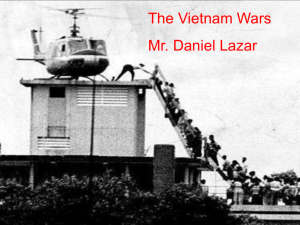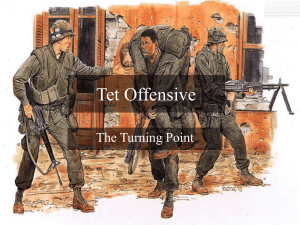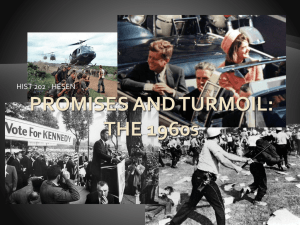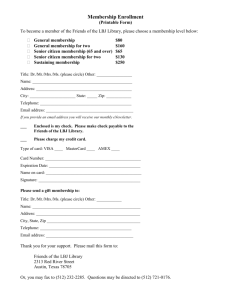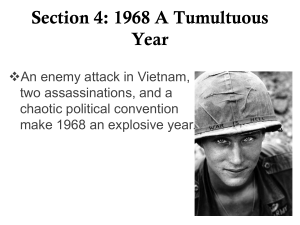APUSH – Vietnam Notes - Miami Killian Senior High School
advertisement
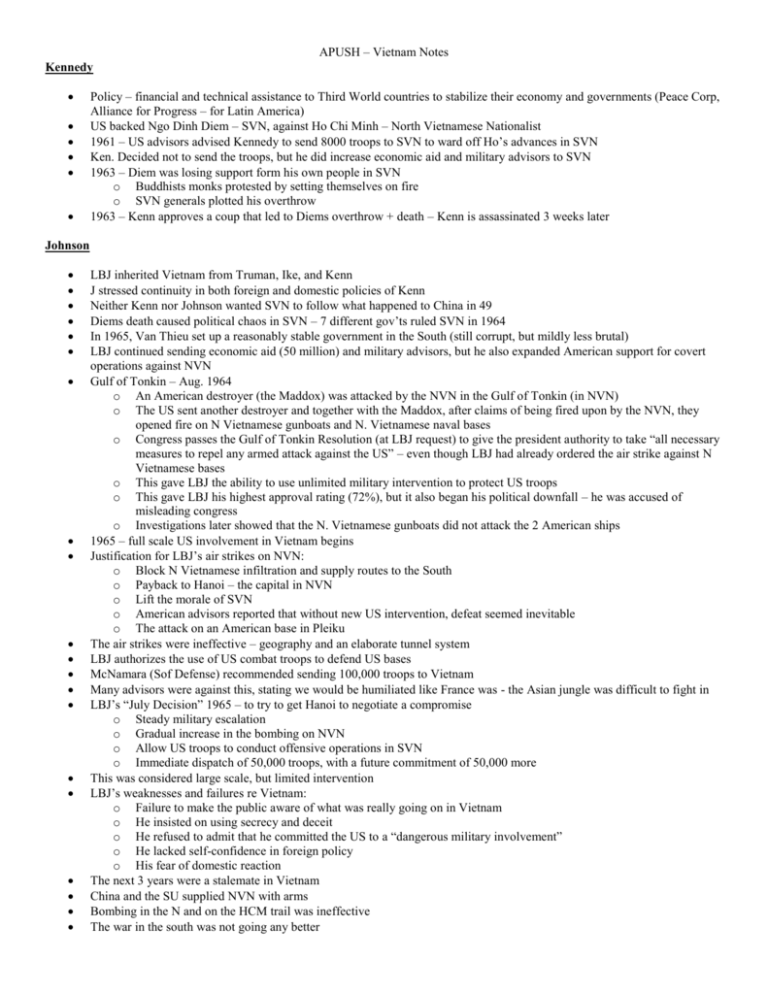
APUSH – Vietnam Notes Kennedy Policy – financial and technical assistance to Third World countries to stabilize their economy and governments (Peace Corp, Alliance for Progress – for Latin America) US backed Ngo Dinh Diem – SVN, against Ho Chi Minh – North Vietnamese Nationalist 1961 – US advisors advised Kennedy to send 8000 troops to SVN to ward off Ho’s advances in SVN Ken. Decided not to send the troops, but he did increase economic aid and military advisors to SVN 1963 – Diem was losing support form his own people in SVN o Buddhists monks protested by setting themselves on fire o SVN generals plotted his overthrow 1963 – Kenn approves a coup that led to Diems overthrow + death – Kenn is assassinated 3 weeks later Johnson LBJ inherited Vietnam from Truman, Ike, and Kenn J stressed continuity in both foreign and domestic policies of Kenn Neither Kenn nor Johnson wanted SVN to follow what happened to China in 49 Diems death caused political chaos in SVN – 7 different gov’ts ruled SVN in 1964 In 1965, Van Thieu set up a reasonably stable government in the South (still corrupt, but mildly less brutal) LBJ continued sending economic aid (50 million) and military advisors, but he also expanded American support for covert operations against NVN Gulf of Tonkin – Aug. 1964 o An American destroyer (the Maddox) was attacked by the NVN in the Gulf of Tonkin (in NVN) o The US sent another destroyer and together with the Maddox, after claims of being fired upon by the NVN, they opened fire on N Vietnamese gunboats and N. Vietnamese naval bases o Congress passes the Gulf of Tonkin Resolution (at LBJ request) to give the president authority to take “all necessary measures to repel any armed attack against the US” – even though LBJ had already ordered the air strike against N Vietnamese bases o This gave LBJ the ability to use unlimited military intervention to protect US troops o This gave LBJ his highest approval rating (72%), but it also began his political downfall – he was accused of misleading congress o Investigations later showed that the N. Vietnamese gunboats did not attack the 2 American ships 1965 – full scale US involvement in Vietnam begins Justification for LBJ’s air strikes on NVN: o Block N Vietnamese infiltration and supply routes to the South o Payback to Hanoi – the capital in NVN o Lift the morale of SVN o American advisors reported that without new US intervention, defeat seemed inevitable o The attack on an American base in Pleiku The air strikes were ineffective – geography and an elaborate tunnel system LBJ authorizes the use of US combat troops to defend US bases McNamara (Sof Defense) recommended sending 100,000 troops to Vietnam Many advisors were against this, stating we would be humiliated like France was - the Asian jungle was difficult to fight in LBJ’s “July Decision” 1965 – to try to get Hanoi to negotiate a compromise o Steady military escalation o Gradual increase in the bombing on NVN o Allow US troops to conduct offensive operations in SVN o Immediate dispatch of 50,000 troops, with a future commitment of 50,000 more This was considered large scale, but limited intervention LBJ’s weaknesses and failures re Vietnam: o Failure to make the public aware of what was really going on in Vietnam o He insisted on using secrecy and deceit o He refused to admit that he committed the US to a “dangerous military involvement” o He lacked self-confidence in foreign policy o His fear of domestic reaction The next 3 years were a stalemate in Vietnam China and the SU supplied NVN with arms Bombing in the N and on the HCM trail was ineffective The war in the south was not going any better By early 1968, the US had over 500,000 ground forces in SVN, yet the Viet Cong still controlled much of the South My Lai Massacre – March 1968 – more than 200 unarmed villagers were killed Public opinion gradually started to turn against the war US used conventional warfare in an unconventional war Strategies: o Attrition – damage until surrender o Heavy bombing – on Ho Chi Minh Trail o Pacification – win the hearts and minds of the Vietnamese o Relocation – sent 3 million refugees to “camps”, destroyed villages in South using Napalm, it was “necessary to destroy the village in order to save it” Tet Offensive – Jan 30, 1968 o Turning point of the Vietnam War o Vietcong (Southern Nationalists) attacked American strongholds in SVN o Main raid was in Saigon, at the American Embassy o Battle was televised for 6 hours o The US was able to hold on to their strongholds in SVN, but it was a moral defeat for the US – and a political defeat for LBJ - public opinion strongly turned against the war o On March 31, 1968, LBJ chose not to run again for president We were winning most of the battles, but not the war NIXON Inaugural message in 1969 – he will bring “peace with honor” New policy for Vietnam (led by Kissinger) o Limit domestic opposition o New “lottery” for draft o “Vietnamization” – train S Vietnamese and arm them so they can fight for themselves o Gradual withdrawal of American troops – 1969 = 540,000 1972 = 60,000 Nixon and Kissinger decided to destroy military bases in Cambodia He kept the raids secret from congress and the public A coup overthrew the neutral Cambodian gov’t and they were replaced w/ Pro American Regime – led by General Lon Nol (probably w/ US help) Lon Nol allowed US troops into Cambodia to “clean out” the bases This boosted the anti-war sentiment in the US – (Kent State, Jackson State) Congress repealed the Gulf of Tonkin Resolution – Dec 1970 1971 – The Pentagon Papers – a secret study of the war during LBJ’s administration - first published by the NY Times o Stated that the gov’t had not been telling the truth in reporting the progress and motives of the war o “we were at war to protect American prestige, not protect South Vietnamese” o Stated morale among troops was declining o The war was becoming increasingly savage – My Lai Massacre, o The US government was discrediting ant-war groups – leaking personal info of protesters US helps SVN invade Laos- S Vietnamese were defeated US bombings in NVN and Cambodia increase Jan 1973 – After continued bombing and several cease fire talks, NVN signed an agreement o There was an immediate cease fire o POWs were released – boosted Nixon’s ratings o N Vietnamese forces in South Vietnam would get to stay o A permanent settlement would be worked out later 1973 – War Powers Resolution passed by congress o basically took away all the powers given to the President by the Gulf of Tonkin Resolution o this provides that the President can send U.S. armed forces into action abroad only by authorization of Congress or in case of "a national emergency created by attack upon the United States, its territories or possessions, or its armed forces." o The War Powers Resolution requires the President to notify Congress within 48 hours of committing armed forces to military action Ford 1975 – N Vietnam begins an offensive attack on S Vietnam The North ended up occupying the South and then united Vietnam Ford asked congress for funding to help S. Vietnam, but they refused April 1975 = the fall of Saigon Lon Nol in Cambodia fell to Pol Pot and the Khmer Rouge (the ruling communist party) – 1/3 of the population was killed
![vietnam[1].](http://s2.studylib.net/store/data/005329784_1-42b2e9fc4f7c73463c31fd4de82c4fa3-300x300.png)
